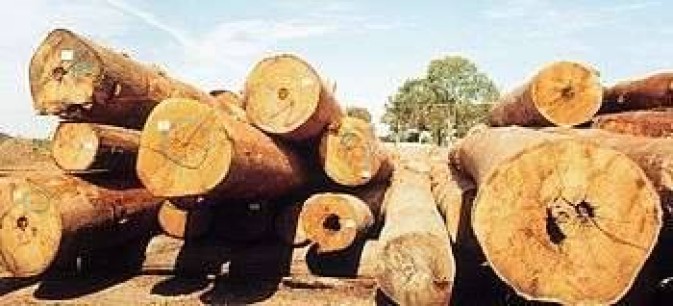Above: Blackbutt logs in the J. Notaras & Sons yard at South Grafton.
Blackbutt, or Eucalyptus pilularis, has been one of the mainstays of the New South Wales timber industry for more than a century. Howard Spencer talks to north coast sawmillers Spiro and Brinos Notaras about the quality and various uses of this native timber.
Growing up to a height of 45 metres with a diameter of 1.2 metres, blackbutt gets its common name from the bark around the base, which changes to a smooth surface towards the upper trunk and limbs.
Blackbutt is plentiful in State forests, occurring on various soils but making better progress on light, deep loams. It is one of the most common coastal trees and reproduces readily from natural seeding. Blackbutt contributes around 22 per cent of the State's timber production, well ahead of the next two major native forest timbers, cypress pine and spotted gum, which each deliver about 14 per cent. Blackbutt is also one of the major species being planted in State Forests' hardwood plantation program.
Timber from blackbutt has been used for a wide variety of purposes, including general joinery, feature flooring, veneers, sleepers, poles and girders. It is widely used in bridge building but is equally at home in all facets of home-building.
And the sawmillers just love it.
According to veteran Grafton millers, Spiro and Brinos Notaras of J. Notaras & Sons, blackbutt lays flatter than spotted gum, another major species, and there is not as much tension in the wood as either spotted gum or ironbark.
"We've sawn blackbutt since we started the mill in 1952," says Spiro.
"But since State Forests introduced log merchandising we have seen a lot more of it. Now it is nearly 15 per cent of our business."
The Notaras blackbutt comes from State forests like Clouds Creek, Wild Cattle Creek and elsewhere in the Dorrigo area. It is milled within a week or two of harvest, where it is sawn to board dimension, stripped for air drying for around two months, then spends three weeks in the kiln drying to nine or 10 per cent moisture level. After a short equalisation in the shed, its final process is steam reconditioning.
"We are continually testing and learning," Spiro said.
"The blackbutt looks good, and has more of an even colour than other species. There can be a bit of variation in native regrowth blackbutt, while plantation blackbutt is lighter."
The Notaras mill has just completed a trial operation with State Forests where blackbutt logs were computer-tracked through the harvest and milling process to the finished board. The results will assist in determining how best to grow and treat blackbutt from seedling to sale in the future.
Notaras blackbutt goes into products as diverse as basketball courts, because of its superior fire rating against other timbers, and into household and commercial flooring, parquetry, decking and furniture.
Other products from this universal timber end up in mixed hardwood lots sold to New Zealand, and in mixed hardwood floors that are a feature of many Queenslander style homes north of the border.
With valuable applications like these, blackbutt will continue to be an important timber species for many years to come.
Howard Spencer
Public Affairs, Coffs Harbour
NSW DEpartment of Primary Industries site:
http://www.forest.nsw.gov.au/bush/aug01/stories/23.asp
